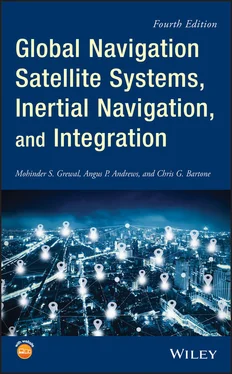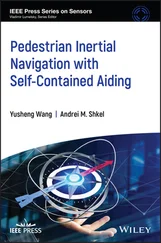Chapter 3covers the fundamentals of inertial navigation, starting with its nomenclature, and continuing through to practical implementation methods, error sources, performance attributes, and development strategies.
Chapters 4– 9cover basic theory of GNSS for a senior‐level class in geomatics, electrical engineering, systems engineering, and computer science. Subjects covered in detail include basic GNSS satellite signal structures, practical receiver antenna designs, receiver implementation structures, error sources, signal processing methods for eliminating or reducing recognized error sources, and system augmentation methods for improving system integrity and security.
Chapter 10covers the fundamental aspects of Kalman filtering essential for GNSS/INS integration: its mathematical foundations and basic implementation methods, its application to sensor integration in general, and to GNSS navigation in particular. It also covers how the implementation includes its own performance evaluation, and how this can be used in performance‐predictive design of sensor systems.
Chapter 11covers the basic errors sources and models for inertial navigation, including the effects of sensor noise and errors due to drifting inertial sensor error characteristics, how the resulting navigation errors evolve over time, and the resulting models that enable INS integration with other sensor systems.
Chapter 12covers the essential mathematical foundations for GNSS/INS integration, including a unified navigation model, its implementation in MATLAB, evaluations of the resulting unified system performance under simulated dynamic conditions, and demonstration of the navigation performance improvement attainable through integrated navigation.
Appendix A contains brief descriptions of the MATLAB® software, including formulas implementing the models developed in MATLAB® different chapters and used for demonstrating how they work. Appendix B and Appendix C (www.wiley.com/go/grewal/gnss) contains background material on coordinate systems and transformations implemented in the software, including derivations of the rotational dynamics used in navigation error modeling and GNSS/INS integration.
For instructors that wish to cover the fundamental aspects of GNSS, Chapters 1– 2and 4– 9are recommended. Instructors for a course covering the fundamental concepts of inertial navigation can cover Chapters 1, 3, 10, and 11. A follow‐on class or a more advanced course in GNSS and INS integration should include Chapter 12as well as significant utilization of the software routines provided for computer‐based GNSS/INS integration projects.
October 2019
Mohinder S. Grewal, Ph.D., P.E . California State University at Fullerton Fullerton, California
Angus P. Andrews, Ph.D . Rockwell Science Center (retired) Thousand Oaks, California
Chris G. Bartone, Ph.D., P.E . Ohio University Athens, Ohio
We acknowledge Professor John Angus, Jay A. Farrell, and Richard B. Langley for assistance and inspiration on the outline of this edition. We acknowledge the assistance of Mrs. Laura A. Cheung of the Raytheon Company for her expert assistance in reviewing Chapter 8 (Differential GNSS) and with the MATLAB® programs. Special thanks goes to Dr. Larry Weill for his contribution to Chapter 7 on multipath mitigation algorithms.
A. P. A. thanks Andrey Podkorytov at the Moscow Aviation Institute for corrections to the Schmidt–Kalman filter; Randall Corey from Northrop Grumman and Michael Ash from C. S. Draper Laboratory for access to the developing Draft IEEE Standard for Inertial Sensor Technology; Dr. Michael Braasch at GPSoft, Inc. for providing evaluation copies of the GPSoft INS and GPS MATLAB Toolboxes; Drs. Jeff Schmidt and Robert F. Nease, former Vice President of Engineering and Chief Scientist at Autonetics, respectively, for information on the early history of inertial navigation; and Edward H. Martin, member of the GPS development team awarded the 1992 Robert J. Collier Trophy by the National Aeronautics Association, and winner of the 2009 Captain P.V.H. Weems Award presented by the Institute of Navigation for his role in GPS receiver development, for information on the very early history of GPS/INS integration.
C. G. B. would like to thank Ohio University and many of its fine faculty, staff, and students that I have had the pleasure to interact with in my research and teaching over the years. Such a rich environment has enabled me to develop a wide variety of classes and research efforts that these writings draw upon. Thanks also goes to Neil Gerein and Jerry Freestone from NovAtel, Dave Brooks from Sensor Systems, James Horne from Roke, and Herbert Blaser from u‐blox for providing antenna information.
Mohinder S. Grewal, Ph.D., P.E., is well known for his innovative application of Kalman filtering techniques to real world modeling problems and his ability to communicate this complex subject to his students. His original research appears in IEEE and ION refereed journals and proceedings. He holds patents in GUS clock steering and L 1/L 5differential bias estimation. Dr. Grewal is Professor of Electrical Engineering at California State University, Fullerton, which awarded him its 2008-2009 Outstanding Professor Award. His consulting associations include Raytheon Systems, Boeing Company, Lockheed‐Martin, University of California, Riverside, staff of the US Department of the Interior, Geodetics, and Northrop. He is a Senior Member of IEEE and member of the Institute of Navigation. His Ph.D. in Control Systems and Computers is from University of Southern California.
Angus P. Andrewsderived the first electrostatic bearing torque parametric models for calibrating electrostatic gyroscopes in 1967 at the Autonetics Division of Rockwell International, and then saw its development through two generations of strapdown inertial navigation systems to the N73 competitor for the US Air Force Standard Navigator. His career in inertial navigation also included derivations of new square root filtering formulas. His undergraduate degree is from MIT and his Ph.D. in mathematics is from University of California, Los Angeles.
Chris G. Bartone, Ph.D., P.E., is a professor at Ohio University with over 35 years experience in communications, navigation, and surveillance systems. He received his Ph.D., E.E. from Ohio University, M.S.E.E. from the Naval Postgraduate School, and B.S. E.E. from The Pennsylvania State University. Dr. Bartone has developed and teaches a number of GNSS, antenna, and microwave classes. He is a recipient of the RTCA William E. Jackson award, the ION Captain P.V.H. Weems award, and is a Fellow of the ION. His research concentrates on all aspects of navigation systems.
About the Companion Website
This book is accompanied by a companion website:
www.wiley.com/go/grewal/gnss

The website includes:
Solution Manual for Instructors only
MATLAB files for selected chapters
Appendices B and C
A book on navigation? Fine reading for a child of six!1
During the European Age of Discovery, in the fifteenth to seventeenth centuries, the word navigation was synthesized from the Latin noun navis (ship) and the Latin verb stem agare (to do, drive, or lead) to designate the operation of a ship on a voyage from A to B – or the art thereof.
Читать дальше













